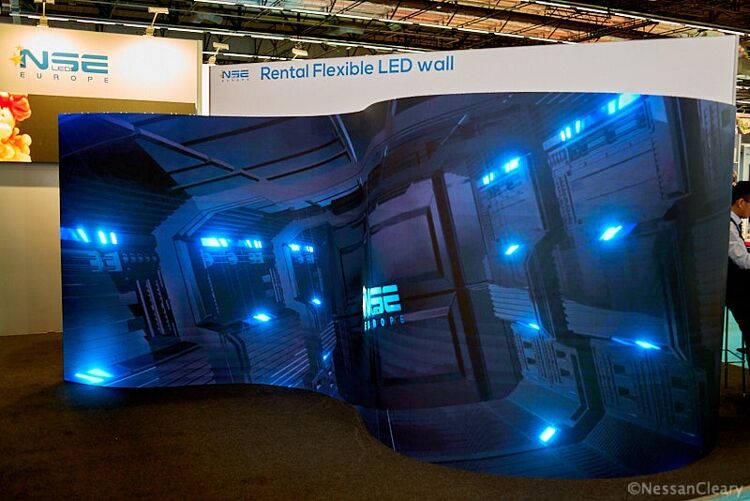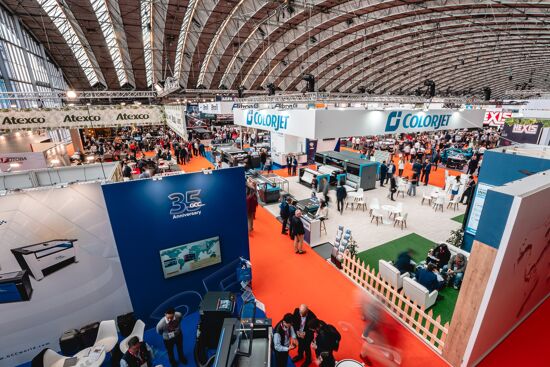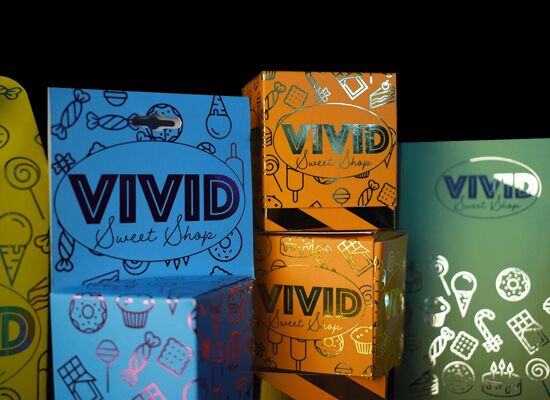The opportunities in indoor large format print

Nessan Cleary discusses the numerous opportunities in indoor large format for printers, some are designed for both short term and long term use. Nessan also shares the advantages of offer indoor displays, the various print technologies as well as sustainable options for this sector.
There are a lot of opportunities for display graphics in indoor locations, from shopping centres and retail units through to transport hubs, museums and public buildings. Some of this will be for long term use, such as way finding signs, but a great deal will be relatively short lived in support of particular campaigns or seasonal messages.
There’s a huge range of different products that can be produced for indoor graphics, starting with posters and banners, as well as light boxes, flags and portable display stands. There are a lot of different spaces that can be used, from windows and floors to walls and ceilings. The opportunities also include point of sale displays, ranging from counter-top to floor standing, and items like dump boxes. And of course you can go beyond simple display items to include counter tops, tables, and seating with branded upholstery.
 This WF1-L640 latex printer is Brother's first entry into the wide format market. ©Nessan Cleary
This WF1-L640 latex printer is Brother's first entry into the wide format market. ©Nessan Cleary
One advantage of working indoors is that you don’t have to worry about the weather and you have a lot more control over the environment, which gives you a lot of choice in the design of the displays, the type of inks used and the materials to print to. However, you may still have to consider the risk of colours fading from sunlight if the graphic is to be located in a window, depending on the expected service life of the display.
Some indoor locations will also have additional health and safety requirements, such as for flame retardence, which may dictate your choice of some materials. There may also be some conditions on installation, such as insisting on additional safety chains in case a graphic comes loose from its fitting. The venue owners will also be wary of traffic flows, which may limit the placing of some display items, particularly around fire exits.
Another consideration is that the viewing distance for indoor applications is generally much closer than outdoor displays, meaning that you will likely need higher resolution prints with more passes, which may take longer to produce. However, the fact that the prints are closer to the viewers also offers an opportunity to play around with different effects, including textured and even tactile surfaces that can encourage more interaction with passersby.
 Indoor spaces also lend themselves to digital signage. ©Nessan Cleary
Indoor spaces also lend themselves to digital signage. ©Nessan Cleary
Print technology
Working indoors means that you have more choice over the ink and printer technology that you can use. That could include both aqueous ink, as well as latex or resin, which are cheaper to buy, both for the ink and the printers, than UV-curable machines. That means that indoor graphics can offer print companies a relatively less expensive way into the display graphics market. Equally, you can free up the more expensive UV printer for more lucrative work.
There’s a growing number of latex machines coming to the market now, largely because the water-based resin ink is seen as more environmentally-friendly than UV-curable ink. This ink contains binders that encapsulate the pigments, bonding to the substrate when the ink is heated. HP is the best known supplier thanks to its decision many years ago to concentrate its large format efforts on its latex ink, so that it’s portfolio includes both 3.2m wide roll fed printers and flatbeds. But Epson, Ricoh, Roland and Brother also sell printers, branded either as latex or resin, though for now most of these are 1.6m wide roll fed machines.
There’s a lot of advantages in using textiles for display graphics in interior settings. For a start, textiles are more environmentally-friendly than most substrates and are easy to recycle after use. Moreoever, they are lightweight and can be rolled up or folded so they have a very small environmental footprint in terms of transport to the site. They can also be easily treated for flame retardence, which is an important consideration for many venues.
You can print to textile with UV or latex inks but you can get better results with dye sublimation. The process is more involved than other alternatives but can also be used for other markets such as apparel. For best results you should print to a transfer paper and then run the transfer paper and textile through a heat press, which will force the ink to sublimate from the paper right into the fabric. Some machines are designed to print directly to the textile material for display graphics. These usually have built-in heating from infrared lamps to cure the ink and are available in widths from 3.2m up to 5m, and mostly aimed at the exhibition print market.
Besides textiles, there’s a huge choice in other substrates that are suitable for indoor use, including many that offer good recyclability, which is of growing concern to both consumers and corporate customers. The most obvious is paper but there are also several paper-based boards from vendors such as Dufaylite or Reboard. These typically use a honeycomb interior structure that gives excellent strength to weight ratio. They can be used for building three dimensional structures such as counter-tops and kiosks as well as dividing walls in large spaces.
 Paper-based boards are an environmentally-friendly way of building counter tops and dividing walls for indoor spaces. ©Nessan Cleary
Paper-based boards are an environmentally-friendly way of building counter tops and dividing walls for indoor spaces. ©Nessan Cleary
There are also a number of plastic boards made with a degree of recycled content, which can themselves be recycled, which offer good rigidity and durability combined with light weight for easier installation.
Finally, besides printed graphics there’s also a growing trend towards digital graphics, which really come into its own for indoor spaces. There are two main advantages to digital signage. Firstly, they can be used for moving graphics and even live footage. This is particularly effective on large statement screens but can also be used across several smaller screens with the graphic appearing to move around the space. A good example of this can be seen in some London Underground stations where there are screen beside the escalators and images move from one screen to the next, appearing to travel up or down the escalators with the passengers.
The other advantage is that the screens are networked and can be easily updated so there’s no need to send anyone out to change over the posters. The disadvantage is the cost of the equipment and many venues may feel that its not a worthwhile investment. But you can still hire in screens for short lived events or campaigns.
In conclusion, there are a lot of different products that large format print companies can offer to venues for interior graphics without needing to invest in expensive extra kit. There are plenty of sustainable options and room for creative design that printers can use to differentiate themselves rather than trying to compete on price.
To discover the latest content that covers a wide range of sectors including indoor displays, inks and latex printing sign up for FESPA’s free monthly newsletter FESPA World available in English, Spanish and German.
Interested in joining our community?
Enquire today about joining your local FESPA Association or FESPA Direct
Recent news
.png?width=550)
What qualities should visionaries in print have? With Folker Stachetzki from Brother
We speak to Folker Stachetzki, Head of Marketing at Brother about visionaries in print.

Bolstering personalisation by combining print and digital technology
Using printed material in combination with digital technologies offers more opportunities to those offering personalisation to customers. Rob Fletcher shares some recent examples of the print and digital working together to enhance the impact of personalised pieces.

European Sign Expo to highlight developments shaping the future of signage and visual communications
European Sign Expo 2025 (6 – 9 May, Messe Berlin, Germany) is weeks away and a host of leading exhibitors are all set to welcome Visionaries from across the signage and visual communications industries to their stands.
